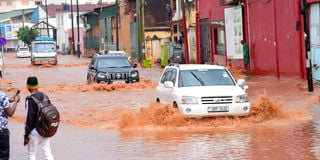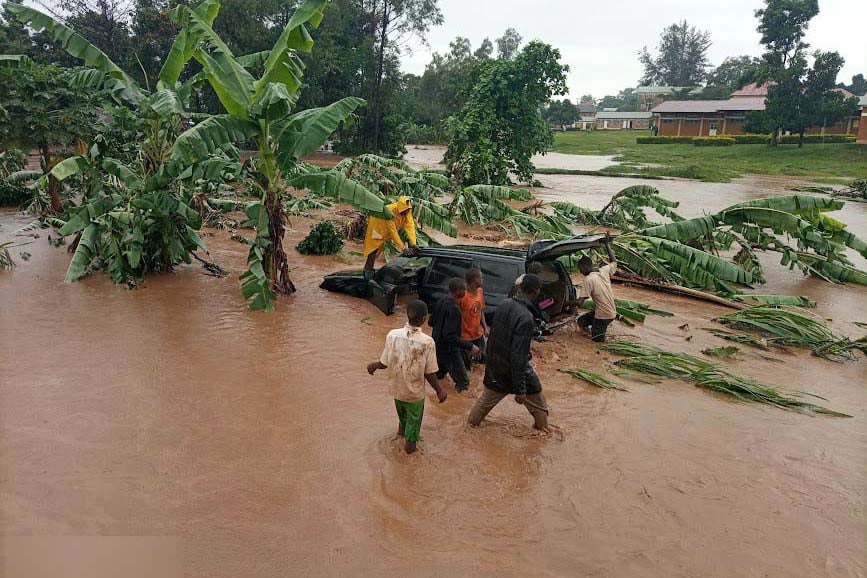Prime
Uganda risks losing Shs12 trillion in natural disasters

Motorists wade through a flooded section of 7th Street in Kampala after a downpour on September 12, 2022. The December 2023 value-for-money audit report by the Auditor General indicates that the Works sector was the most affected by natural disasters with losses as high as Shs206 billion. PHOTO/FRANK BAGUMA
What you need to know:
The Auditor General noted that the study further predicted that the frequency of extreme events was likely to “double every 25 years” and could result in “damages of $938 million (Shs3.6 trillion) to $3.2 billion (Shs12 trillion) by 2050” if no action is taken to avert or help in adaptation
The Auditor General has asked the government to expedite the implementation of climate change mitigation and adaptation interventions to avert the potential loss of $3.2 billion (Shs12.4 trillion) that extreme weather events are projected to cause.
In the December 2023 value-for-money audit report, the Office of the Auditor General stated that when they reviewed the disaster report from the Office of the Prime Minister, they found the country lost Shs373 billion in one year because of “extreme climate-related weather events” such as flood and drought.
According to the report, the central region was the most affected with a loss of Shs81 billion, followed by Rwenzori (Shs78.8 billion), Busoga (Shs51 billion), Elgon (Shs40.7 billion), and Southwest (Shs40.6 billion).
Lango came sixth with a loss of Shs40 billion, Karamoja (Shs36.4 billion) and Bunyoro and West Nile being the least affected each getting a loss of Shs2.1 billion.
The Auditor General specifically assessed the reported effects on the five sectors: Water, Environment, Agriculture, Health and Works where the total loss was found to be Shs373 billion. The report indicates that the Works sector was the most affected with losses as high as Shs206 billion.
Losses related to the Works sector include road infrastructure destruction by floods. The Water sector lost Shs23.8 billion, Environment (Shs33.7 billion), Agriculture (Shs77.3 billion) and Health (Shs31.8 billion).
“Related to the above, a 2015 study by the Ministry of Water and Environment analysed the economic impacts of climate inaction across key sectors, and found that whereas the cost of adaptation was estimated at $406 million (Shs1.6 trillion) annually, the annual cost of inaction was estimated at 20 times higher per year,” the audit report reads.
The study, the Auditor General noted, further predicted that the frequency of extreme events was likely to “double every 25 years” and could result in “damages of $938 million (Shs3.6 trillion) to $3.2 billion (Shs12 trillion) by 2050” if no action is taken to avert or help in adaptation.
“Climate change inaction jeopardises development gains and makes achieving Nationally Determined Contribution targets difficult. This underscores the importance of mainstreaming climate change into all sectors and local government activities,” the audit report reads.
According to the report, due to climate change-related events such as drought, water demand is projected to skyrocket and would result in losses totalling about “$237 million (Shs920.6 billion) yearly, impacting irrigation, livestock, and domestic consumption.”
In agriculture, the report shows: “Coffee production was projected to halve by 2050, incurring $1.2 billion (Shs4.7 trillion) losses. Tea and cotton were also projected to suffer. Food crop losses were smaller but still significant, potentially hitting $1.5 billion (Shs5.8 trillion) by 2050.”
Shortages of biomass (cooking fuel) and hydropower (due to reduced rainfall) were predicted and hydropower potential risked declining by 26 percent, according to the report.
“Buildings and transport were found to be the most vulnerable. Costs of adaptation were low compared to repair costs, making resilience investments a priority. Losses from destruction or deterioration of residential buildings alone were projected to reach $60 million (Shs223.1 billion) to $76 million (Shs295.2 billion) by 2025,” the report reads further.

A farmer looks at his garden that has dried due to excessive sunshine last year in Kases District. Prolonged droughts are a result of climate change. PHOTO/file
What is climate change?
According to scientists, climate change is the long-term variation (observed over 30 or more years) in the weather patterns of specific areas, regions or the entire world as a result of natural and/or human-induced factors.
The main human factors contributing to climate change include the burning of fossil fuels in industries, vehicles and homes, agricultural and other practices that increase the release of carbon dioxide (CO2), methane and other greenhouse gases into the atmosphere. Deforestation and wetland degradation destroy the vegetation that acts as a sink for excess CO2.
Dr Barirega Akankwasah, the executive director of National Environment Management Authority (Nema), explains that when one destabilizes the wetland (through farming), methane and CO2 gases, which are naturally held by these wetlands under the natural environment, are released into the atmosphere, and these are greenhouse gases.
Information from the United Nations (UN) indicates that when released into the atmosphere, greenhouse gases blanket the earth, trapping the sun’s heat.
“This leads to global warming and climate change. The world is now warming faster than at any point in recorded history. Warmer temperatures over time are changing weather patterns and disrupting the usual balance of nature. This poses many risks to human beings and all other forms of life on Earth,” information from the UN reads.
Mr Stephen Mugabi, the acting director for Environment Affairs at the Ministry of Water and Environment, said the forest cover has declined from 24 percent in the 1990s to 13 percent in 2022, noting that the government has increased interventions to protect forests and promote the planting of more trees.
The wetland coverage has also reduced from 15.5 percent in 1994 and is currently estimated at 8.9 percent, according to statistics from the Ministry of Water and Environment, indicating a fast rate of destruction.
According to Global Forest Watch, between 2001 and 2022, an average of 21.0 metric tonnes per year was released into the atmosphere as a result of tree cover loss in Uganda and “in total, 463 metric tonnes of CO2 was emitted in this period.”
The emissions from Uganda are too low when compared to US greenhouse gas emissions. According to statistics from the website of the US Environmental Protection Agency, the greenhouse gas emissions in the US totalled 6.3 billion metric tonnes of carbon dioxide equivalents in 2022, and 5.5 billion metric tonnes of CO2 equivalents after accounting for sequestration from the land sector. Highly industrialised countries have been emitting more greenhouse gases, according to environmentalists.
“We (Uganda and Africa) are contributing the least to the climate crisis and to climate change,” Ms Hamira kobusingye, a climate justice activist from Fridays for Future Africa, said, adding, “but we bear the brunt of the climate crisis.”
“We have seen the floods that happened in Malaba, what has happened in Karamoja, drought and food scarcity which are the result of climate change,” she added.
Tree Adoption Uganda, a climate awareness organisation led by Dr Charles Batte, in their letter to this publication, also noted: “It is no secret that Uganda is grappling with the adverse effects of climate change that have among others, manifested in the forms of drought, floods and changes in weather patterns depending on the region that one originates from.”
The organisation said these calamities should serve as a wake-up call to the country to be at the forefront of a green revolution in 2024 aimed at securing a sustainable future for generations to come.
Actions and bottlenecks
According to information from the government, climate change mitigation measures in Uganda focus on tackling the root cause of human-induced climate change by avoiding or preventing the emission of greenhouse gases, or neutralisation through afforestation or reforestation.
Adaptation, on the other hand, focuses on adjustment to actual or expected climate change and its effects. Adaptation seeks to moderate or avoid harm arising from a changing climate or exploit beneficial opportunities that this change may offer.
The Climate Change Department (CCD) at the Ministry of Water and Environment was created to spearhead and coordinate all of the government’s adaptation and mitigation efforts at central and local government levels, in collaboration with both national and international actors.
However, in the December 2023 audit report, the CCD is struggling with the implementation of activities because of low funding and understaffing.
“…the department had to grapple with extremely low government funding over the last three years (38 percent of required resources) and this hindered implementation of planned activities and left the department mostly dependent on donor support, whose climate action priorities were not always aligned with the government’s,” the audit report reads.
The report further states: “Moreover, despite the fact that the Climate Change Department (CCD) shoulders a vast responsibility (coordinating national climate action, managing international financing, and leading Uganda’s climate change diplomacy), its current structure only provides for 30 staff, instead of a proposed 95 staff.”
The audit team also established that during the entire review period, the CCD did not train any districts on how to integrate climate change and disaster risk reduction in their plans, budgets, and reports nor did any Ministries, Departments and Agencies (MDAs) in climate risk screening of projects and programmes.
According to government figures, in the last three years, between 2017 and 2020, the government gave the CCD around Shs5 billion.
“However, it trained seven out of the planned 85 District Local Governments on climate risk screening of projects and programmes. The audit team found that against a planned Shs5.12 billion for all National Development Plan (NDP) III activities (including capacity building, awareness raising, monitoring, etc.), the department received only Shs1.95 billion- just 38 percent of the NDP III PIAP target,” the audit report reads.
This audit revealed some instances of failure to adequately mainstream climate change in the Agriculture, Energy, Water and Environment, Works and Transport, and Health Sectors, resulting in severe consequences.
“The accounting officer (MWE) should annually plan for and engage the Finance Ministry to ensure the release of the funds required to implement planned NDPIII activities, including capacity building and training of MDAs and District Local Governments in climate change mainstreaming,” the audit report reads.
Losses due to climate change
Regional
Central Shs81b
Rwenzori Shs78.8b
Busoga Shs51b
Elgon Shs40.7b
South West Shs40.6b
Lango Shs40b
Karamoja Shs36.4b
Bunyoro Shs2.1b
West Nile Shs2.1b
Sectoral
Works Shs206b
Agriculture Shs77.3b
Environment Shs33.7b
Health Shs31.8b
Water Shs23.8b

Farmers attend to a rice field in Kween. Government has come up with a policy to persuade the citizens who have rice in wetlands to vacate the wetlands and go into alternative livelihood enterprises. photo/file
Actions/way forward
The December 2023 value-for-money audit report also shows that the government is already working to mainstream climate change intervention. In Agriculture, according to the report, climate-smart agriculture is being promoted, land, water and soil conservation practices are also being strengthened; in addition to increased access and use of water for agricultural production.
In the works sector, there are interventions of constructing, upgrading and climate-proofing strategic transport infrastructure; construction/rehabilitation of metre gauge railway connecting various towns in Uganda; construction of inland ports at Bukasa and on Lake Albert; procurement and use of railway coaches; and expanding ferry service provision.
While in the health sector, interventions are focused on developing, overseeing and implementing programmes in new and emerging areas of space, marine, Biosciences, virology, nuclear, data and climate science.
The management of the CCD, in their official response, said: “The underperformance on this activity is attributed to limited financial allocations to the Climate Change Department to meet the projected planned activity budgets as required in NDPIII.”
“Amidst the challenge of underfunding, management re-prioritised preparation of the national climate change action plan (updated NDC) to guide sectors on the integration of climate change to meet our national and international climate change obligations,” the management added.
“CCD also took proactive action to engage with the World Bank and other Development Partners to build the capacity of Ugandans on the Climate and Disaster Risk Screening (CDRS) in projects and programmes for both government and non-government actors,” the management further stated.
Dr Barirega Akankwasah, the executive director of National Environment Management Authority (Nema), said the government has come up with a policy to persuade the citizens who have rice in wetlands to vacate the wetlands and go into alternative livelihood enterprises like fish farming to minimise the release of greenhouse gases.
“Fish farming can make them [the rice farmers] earn three times higher than rice growing. To grow rice in a wetland, you add chemicals also and this is direct pollution of water that people use and animals also drink or live in. Wetlands are connected to underground water systems. Government has taken a decision that there is no more rice growing in wetlands,” he said.
Mr Alfred Okot Okidi, the Permanent Secretary of the Ministry of Water and Environment, said they have many interventions to protect and conserve the environment. Among the initiatives, he said, is the Running Out of Trees (ROOTs) campaign which was born out of the need to involve every Uganda to contribute to the national restoration aspirations through increased public awareness and participation.
“We have in place the Uganda National REDD+ strategy to address the drivers of deforestation and forest degradation against which Uganda’s Bonn challenge commitment to restore 2.5 million hectares of degraded forest landscape by 2030,” he said.
In their advice contained in a letter to this publication, Tree Adoption Uganda said Uganda could focus on what can be achieved with ease.
“Usually when environmental conservation conversations are initiated, most stakeholders think of the “go big” approach like planting 10,000 trees at once or even an entire forest! Much as this approach actually works, not everyone may have the capacity and resources to single-handedly plant 10,000 trees in Uganda this year,” the organisation advised.
“As part of the resolutions for this year, each Ugandan could make a commitment to plant a single tree. With approximately 40 million Ugandans, if this commitment is made, we could be adding a minimum of 40 million trees to Uganda’s forest cover in 2024! This would go a long way in restoring the country’s lost forest cover considering that Uganda’s forest cover has been on the declining trend in the past two decades,” the organisation advised.




